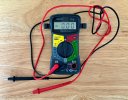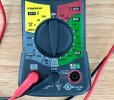Appletax
Well-Known Member
- Reaction score
- 386
- Location
- Northern Michigan
Got a Dell Vostro 7620 laptop with an original Dell OEM AC adapter (130W, 19.5V, 6.7A).
My multimeter is an Innova 3310.
I just wanted to make sure that the adapter is working properly, so I tested the voltage and it output 19.7V. I got to thinking that perhaps I should also test the amperage. I looked up how to do this. I placed the positive red probe into the DC 10A jack and set the multimeter to DC 10A. I put the negative black probe on the outside of the tip and the positive red probe and the inside of the tip and it shut down the AC adapter. I unplugged the adapter and plugged it back in and it appears to be working fine. I ran the built-in UEFI diagnostics on the power supply and it passed.
Apparently, this caused a short-circuit or an overload (not sure which) and the power supply's built-in current limiter / foldback device/fuse prevented this from killing the power supply. It sounds like had the multimeter settings been at a higher amperage, it could have killed the PSU. "The PSU reduces its voltage to limit the short circuit current, while not cutting it off completely so that it can detect if the short is removed."
Should I even bother with testing DCA? How would I go about doing this properly? What did I do wrong?
Also, perhaps it would be nice to have alligator clips for the black probe so I can go hands-free with that probe. There's one at Harbor Freight for only $3. Not sure if it would work with larger PSU tips.
I see that Fluke makes alligator clip probes that the probe can go into. I do not see this type of product as being available from other manufacturers.
Edit:


My multimeter is an Innova 3310.
I just wanted to make sure that the adapter is working properly, so I tested the voltage and it output 19.7V. I got to thinking that perhaps I should also test the amperage. I looked up how to do this. I placed the positive red probe into the DC 10A jack and set the multimeter to DC 10A. I put the negative black probe on the outside of the tip and the positive red probe and the inside of the tip and it shut down the AC adapter. I unplugged the adapter and plugged it back in and it appears to be working fine. I ran the built-in UEFI diagnostics on the power supply and it passed.
Apparently, this caused a short-circuit or an overload (not sure which) and the power supply's built-in current limiter / foldback device/fuse prevented this from killing the power supply. It sounds like had the multimeter settings been at a higher amperage, it could have killed the PSU. "The PSU reduces its voltage to limit the short circuit current, while not cutting it off completely so that it can detect if the short is removed."
Should I even bother with testing DCA? How would I go about doing this properly? What did I do wrong?
Also, perhaps it would be nice to have alligator clips for the black probe so I can go hands-free with that probe. There's one at Harbor Freight for only $3. Not sure if it would work with larger PSU tips.
I see that Fluke makes alligator clip probes that the probe can go into. I do not see this type of product as being available from other manufacturers.
Edit:


Last edited:
